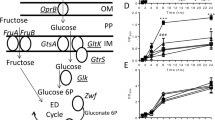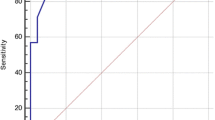Abstract
Objectives
(a) To describe the glucose content of normal human airways secretions; (b) to observe the effects of hyperglycemia and airways inflammation on airways glucose.
Design
Observational studies.
Settings
(a) St George's Hospital Medical School; (b) diabetes mellitus outpatient clinics; (c) adult general intensive care unit.
Patients
Nineteen healthy volunteers, 24 volunteers with acute rhinitis, 20 patients with diabetes mellitus, and 60 patients admitted to a general adult intensive care unit.
Measurements
(a) Non-ventilated patients: simultaneous measurement of blood and nasal glucose concentrations; (b) ICU patients: simultaneous blood, nasal, and endotracheal (ET) glucose concentrations.
Results
Nasal glucose was undetectable in all healthy volunteers. Glucose was detected in 12/24 volunteers with acute viral rhinitis [1 (1–2) mmol l−1] and 18/20 people with diabetes [4 (2–7) mmol l−1]. Glucose was detected in the ET secretions of 31/60 ventilated patients on ICU. Patients with ET glucose had significantly higher blood glucose (9.8±0.4 mmol l−1) than patients without ET glucose (7.2±0.3 mmol l−1, P<0.001), and all patients with blood glucose >10.1 mmol l−1 had glucose in ET secretions. Enteral nutrition did not affect the presence or concentration of glucose in ET secretions.
Conclusions
Glucose is not normally present in airways secretions, but appears where hyperglycaemia or epithelial inflammation occur. The detection of glucose cannot reliably be used to detect enteral feed aspiration.



Similar content being viewed by others
Explore related subjects
Discover the latest articles and news from researchers in related subjects, suggested using machine learning.Abbreviations
- CSF:
-
Cerebrospinal fluid
- HbA1C:
-
Glycosylated haemoglobin
- ICU:
-
Intensive care unit
- SEM:
-
Standard error of mean
References
Barker PM, Boyd CA, Ramsden CA, Strang LB, Walters DV (1989) Pulmonary glucose transport in the fetal sheep. J Physiol 409:15–27
Basset G, Saumon G, Bouchonnet F, Crone C (1988) Apical sodium-sugar transport in pulmonary epithelium in situ. Biochim Biophys Acta 942:11–18
Saumon G, Seigne E, Clerici C (1990) Evidence for a sodium-dependent sugar transport in rat tracheal epithelium. Biochim Biophys Acta 1023:313–318
Hull HF, Morrow G (1975) Glucorrhea revisited. Prolonged promulgation of another plastic pearl. Jama 234:1052–1053
Metheny NA, St John RE, Clouse RE (1998) Measurement of glucose in tracheobronchial secretions to detect aspiration of enteral feedings. Heart Lung 27:285–292
Kinsey GC, Murray MJ, Swensen SJ, Miles JM (1994) Glucose content of tracheal aspirates: implications for the detection of tube feeding aspiration. Crit Care Med 22:1557–1562
Winterbauer RH, Durning RB Jr, Barron E, McFadden MC (1981) Aspirated nasogastric feeding solution detected by glucose strips. Ann Intern Med 95:67–68
Van Crombrugge P, Rottiers R, Vermeulen A (1985) Self blood glucose monitoring: evaluation of Haemo-Glukotest 20–800R, Visidex I and Reflolux. Diabete Metab 11:210–215
Ishikawa N, Oguri T, Isobe T, Fujitaka K, Kohno N (2001) SGLT gene expression in primary lung cancers and their metastatic lesions. Jpn J Cancer Res 92:874–879
Johansen K, Svendsen PA, Lorup B (1984) Variations in renal threshold for glucose in Type 1 (insulin-dependent) diabetes mellitus. Diabetologia 26:180–182
Ruhnau B, Faber OK, Borch-Johnsen K, Thorsteinsson B (1997) Renal threshold for glucose in non-insulin-dependent diabetic patients. Diabetes Res Clin Pract 36:27–33
Reuterving CO, Reuterving G, Hagg E, Ericson T (1987) Salivary flow rate and salivary glucose concentration in patients with diabetes mellitus influence of severity of diabetes. Diabete Metab 13:457–462
Grenby TH, Mistry M (2000) Properties of maltodextrins and glucose syrups in experiments in vitro and in the diets of laboratory animals, relating to dental health. Br J Nutr 84:565–574
Knowles MR, Robinson JM, Wood RE, Pue CA, Mentz WM, Wager GC, Gatzy JT, Boucher RC (1997) Ion composition of airway surface liquid of patients with cystic fibrosis as compared with normal and disease-control subjects. J Clin Invest 100:2588–2595
Author information
Authors and Affiliations
Corresponding author
Rights and permissions
About this article
Cite this article
Philips, B.J., Meguer, JX., Redman, J. et al. Factors determining the appearance of glucose in upper and lower respiratory tract secretions. Intensive Care Med 29, 2204–2210 (2003). https://doi.org/10.1007/s00134-003-1961-2
Received:
Accepted:
Published:
Issue Date:
DOI: https://doi.org/10.1007/s00134-003-1961-2




